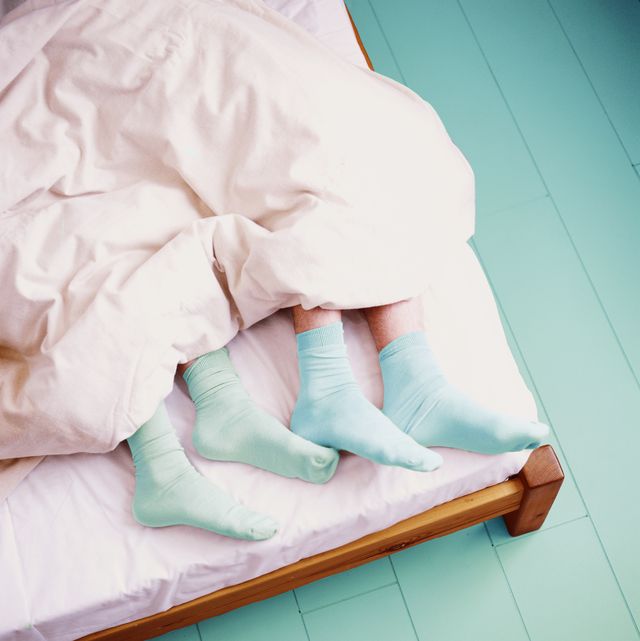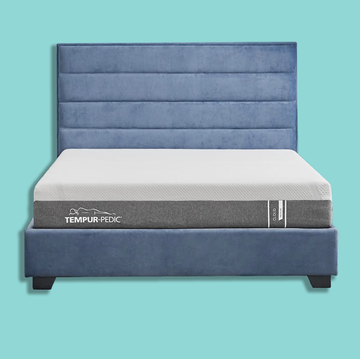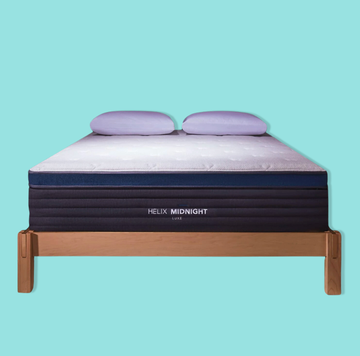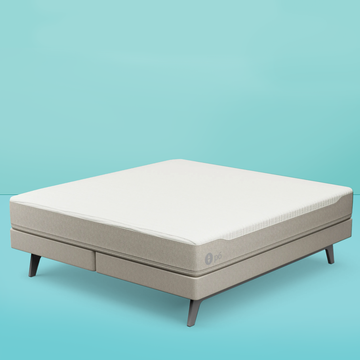Your relationship might be practically perfect in every way, but when it comes to sharing a bed and getting your best night's sleep, even the most in-sync couples can find themselves frustrated. There are many compromises to be made in terms of bed real estate, sleep style and other little things — and they deserve some attention, because everyone's their best self when they're well rested.
"Sleep is very important to our well-being, especially for extending the longevity of life," says Mayank Shukla, M.D., a pulmonologist and sleep doctor in New York City. "Because we spend so much of our time sleeping and together, it's important to plan ahead with your partner. Going to bed at night with your partner should be something you both look forward to — not dread."
See below for some common problems that affect the way couples sleep together, and expert tips for how to share a bed with your partner.
Snoring
First off, if one of you snores, you're going to want to rule out any medical reasons behind it. "Snoring can be a symptom of a bigger problem such as obstructive sleep apnea or allergies," says Janet Kennedy, Ph.D., a clinical psychologist and author of The Good Sleeper." And snoring compromises sleep quality for the snorer as well as the partner, leaving them with daytime sleepiness, headaches, and various other consequences of sleep loss or deprivation."
If those aren't at the root of the problem, there are some over-the-counter solutions the snorer can buy or take to try and reduce it. "There are a variety of devices available that can help, from pillows and sleep positioners, to mouth guards and breathing strips that keep the nasal passages open," Dr. Kennedy adds. "Using a humidifier and saline nasal spray is also helpful." So is side-sleeping, and elevating the head of the bed.
And then there are some steps that the non-snorer can take, too, like going to bed earlier (if possible) to hopefully be asleep by the time the snoring starts. "A larger bed can make a big difference for the partner," Dr. Kennedy says. "Getting a few more inches of distance can really help. Earplugs and white noise might also do the trick."
Differing Temperature Preferences
We each have our favorite sleep conditions: the ideal temperature of the room, firmness of the mattress, the right number of pillows and blankets. You have to take these on a compromise-by-compromise basis.
For example, "A cool sleeping environment — 60 to 67 degrees — is optimal for most people," says Natalie D. Dautovich, Ph.D., assistant professor at Virginia Commonwealth University and member of the National Sleep Foundation. "However, if you differ from your partner in your temperature preferences, consider separate bedding and wearing warmer or cooler pajamas to bed to compensate."
In this case, it's probably up to the person who likes to be warmer to get the extra-warm PJs and blankets. "It’s very hard to sleep when you are overheated, so it's harder for the person who likes to be cooler to compromise," Dr. Kennedy says. "But there are special fabrics for pajamas and bedding that can wick away moisture to keep you cooler. And mattress companies are joining the mix with better airflow and even cooling pads that can help the hot sleeper to be more comfortable."
When it comes to firmness, you probably have to fix that at the mattress level. "Purchasing a mattress with dual comfort settings is a great investment," Dr. Shukla says. "Mattress pads or mattress toppers are also available, but that's a more cost-prohibitive option and, when you're co-sleeping, both levels of the bed should be the same. If you wake up tired with an achy back, that's a problem. Looking for a different mattress is a simple remedy. Also, give yourself a couple of weeks to get used to your new mattress — patience is key to adjusting to a new sleep surface."
Opposing Sleep Cycles: Early Bird vs. Night Owl
As it turns out, there's only so much control you have over whether or not you're an early riser or late-night partier: everyone has their own "chronotype," or body rhythm that controls your internal sleep clock, and it's hard to fight it. "It’s important for each partner to follow their own sleep schedule and live according to their own chronotype," says Martin Reed, a certified clinical sleep health expert (CCSH) and the founder of Insomnia Coach.
Your chronotype may change as you get older. "We peak in 'eveningness' in young adulthood and gradually become more 'morning types' as we age," says Dr. Dautovich.
But trying to change it on your own may lead to problems. "Night owls who try to go to bed too early often end up with insomnia, for example, because the pressure to sleep when the body is not ready triggers anxiety and frustration," Dr. Kennedy says.
"It's important to follow your internal cues as much as possible, even it means differing bed and wake times," Dr. Dautovich adds. "However, light can help to shift our daily rhythms. Dim light exposure in the evening and bright light exposure in the morning can help to move your bed and wake times earlier."
Bed- and Blanket–Hogging
You go to sleep each night splitting things 50/50, but wake up in the morning with one of you curled in a corner shivering with no blankets. There really is only one solution for this: Invest in a bigger bed, and separate blankets. "For example, you can try two twin-size comforters instead of one large comforter so that you each have your own individual sleeping materials," says Dr. Dautovich. (This also helps if you have different ideal sleep temperatures, since one blanket can be thicker than the other.)
Incidentally, in many European countries, topping the bed with two smaller, separate duvets is the default. IKEA even tried to get what it called the "Swedish way of sleeping," to catch on in the U.K., launching a limited-time "TOG-ether" bundle (aka a set of two twin duvets). Unfortunately, the bundle is not available in U.S. stores, but if you're not into blanket-sharing, just know that you're not alone.
Uninvited Guests (aka Your Kids)
Sharing a bed with one partner is hard enough as it is, but adding a child, who takes up more space and blankets than you can possibly guess, can really disrupt night rhythms.
If you have a child who insists on waking you up at night and crawling into bed with you, it might be time for a little tough love. "Set limits!" says Dr. Kennedy. "It might feel impossible, but it is really important for kids to learn how to fall asleep and return to sleep independently. They sleep better — and are much more pleasant to be around during the day — when they can sleep on their own. And marriages can become very stressed when kids come into the bed, especially when one partner leaves the bed to make room. Parents often feel very stuck in this situation, and outside help — such as a sleep consultant — can make a big difference."
Of course, if you as a family decide that bed sharing works for you, that's a different story (though it's definitely wise to brush up on the American Academy of Pediatrics' guidelines for safe sleeping, which discourage bed sharing with babies). But if your night visitor throws your whole routine upside down, the practice of leading them back to their own bed each night will be worth it in the end.
Late-Night Wake-Ups
If one of you frequently needs to get up in the night, the important word is courtesy. "If you need to get up, then try to go in a separate room and gather yourself or relax," Dr. Shukla says. "If you want to read or look at your phone, please don't engage in these activities while you are next partner." Take your book or tablet in the living room and read until you to start to feel sleepy. Then you can go back to the bedroom.
Calling It Quits
Some people are just sleep-incompatible, and that's okay. "If you're regularly waking up during the night or feel unrested upon awakening due to sharing a bed, consider sleeping separately for a trial period of a couple of weeks to see if your sleep improves," says Dr. Dautovich." Healthy sleep is important for maintaining a good mood and a positive relationship with your significant other, even if you have to sleep separately!"
However, be wary of separate sleeping arrangements if it amounts to putting a patch over a larger problem. "It's important that couples don’t move to separate beds unless this is the long-term goal," Reed says. "For example, if one person has chronic insomnia and they move to the spare bedroom in an attempt to improve their sleep, they would be rearranging their lives to accommodate insomnia. That's not a long-term solution. Even if someone sleeps better after moving to a separate room — which, in the case of insomnia, is rare — the insomnia will usually return as soon as they return to bed-sharing with their partner."
It's the same with snoring: If one of you moves to a different bedroom because of the snoring, you might miss out on treating one of the medical conditions that could be causing it. But if it just turns out that you sleep better in different rooms or beds, it's better to be happy and well-rested than together and sleepless.
Marisa (she/her) has covered all things parenting, from the postpartum period through the empty nest, for Good Housekeeping since 2018; she previously wrote about parents and families at Parents and Working Mother. She lives with her husband and daughter in Brooklyn, where she can be found dominating the audio round at her local bar trivia night or tweeting about movies.













